2015 Peugeot 208 trailer
[x] Cancel search: trailerPage 5 of 341
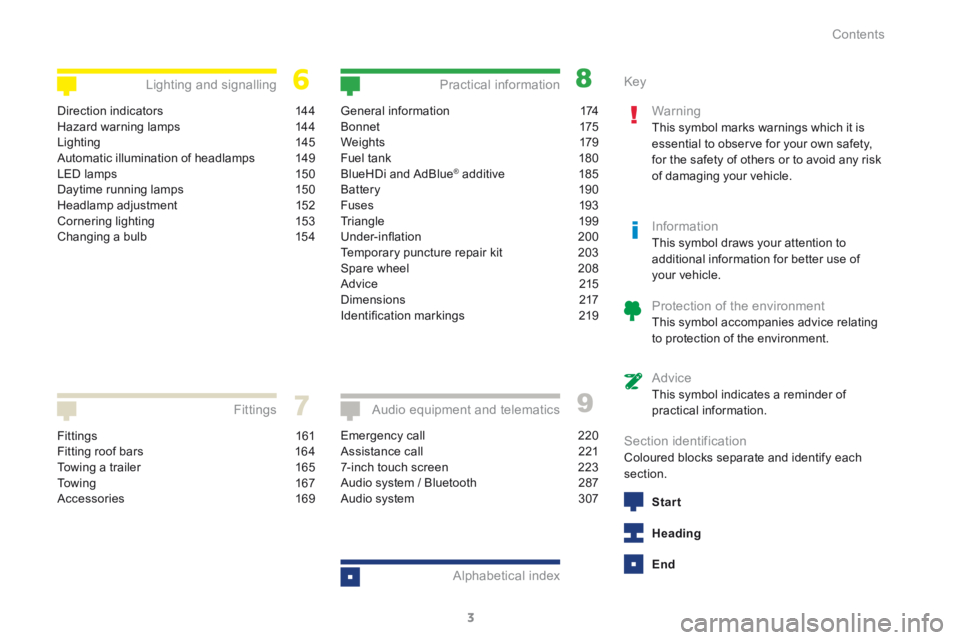
3
208_en_Chap00a_sommaire_ed01-2015
Fittings 161
Fitting roof bars 164
Towing a trailer 165
To w i n g 16 7
Accessories 169
Fittings
General information 174
B o n n et 175
We i g ht s 179
Fuel tank 180
BlueHDi and AdBlue
® additive 185
Battery 190
Fuses 193
Triangle 199
Under-inflation 200
Temporary puncture repair kit 203
Spare wheel 208
Advice 215
Dimensions 217
Identification markings 219
Practical information
Emergency call 220
Assistance call 221
7-inch touch screen 223
Audio system / Bluetooth 287
Audio system 307
Audio equipment and telematics
Alphabetical index
Direction indicators 144
Hazard warning lamps 144
Lighting 145
Automatic illumination of headlamps 149
LED lamps 150
Daytime running lamps 150
Headlamp adjustment 152
Cornering lighting 153
Changing a bulb 154
Lighting and signalling Key
Warning
This symbol marks warnings which it is
essential to observe for your own safety,
for the safety of others or to avoid any risk
of damaging your vehicle.
InformationThis symbol draws your attention to
additional information for better use of
your vehicle.
Protection of the environmentThis symbol accompanies advice relating
to protection of the environment.
AdviceThis symbol indicates a reminder of
practical information.
Section identificationColoured blocks separate and identify each
section.
Start
Heading
End
Contents
Page 122 of 341
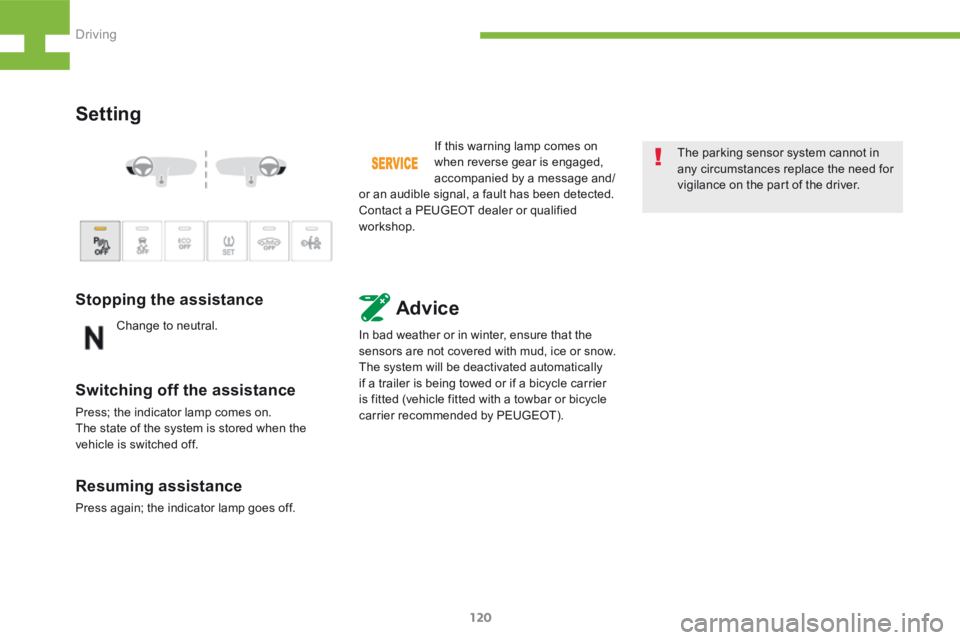
120
208_en_Chap05_conduite_ed01-2015
Setting
Stopping the assistance
Switching off the assistance
Press; the indicator lamp comes on.
The state of the system is stored when the
vehicle is switched off.
Resuming assistance
Press again; the indicator lamp goes off.
AdviceChange to neutral.In bad weather or in winter, ensure that the
sensors are not covered with mud, ice or snow.
The system will be deactivated automatically
if a trailer is being towed or if a bicycle carrier
is fitted (vehicle fitted with a towbar or bicycle
carrier recommended by PEUGEOT).If this warning lamp comes on
when reverse gear is engaged,
accompanied by a message and/
or an audible signal, a fault has been detected.
Contact a PEUGEOT dealer or qualified
workshop. The parking sensor system cannot in
any circumstances replace the need for
vigilance on the part of the driver.
Driving
Page 127 of 341
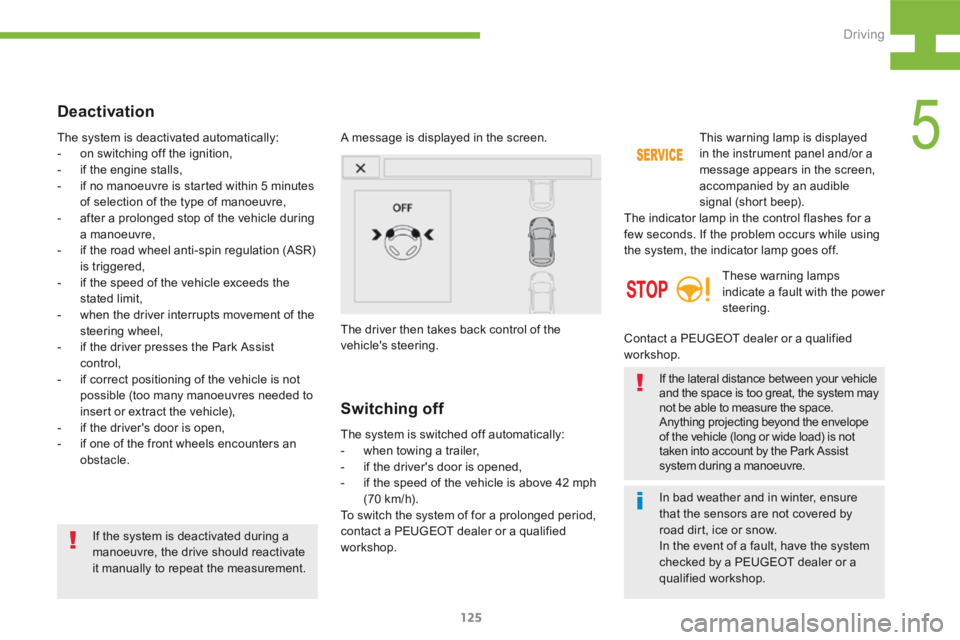
125
208_en_Chap05_conduite_ed01-2015
In bad weather and in winter, ensure
that the sensors are not covered by
road dirt, ice or snow.
In the event of a fault, have the system
checked by a PEUGEOT dealer or a
qualified workshop.
If the system is deactivated during a
manoeuvre, the drive should reactivate
it manually to repeat the measurement. If the lateral distance between your vehicle
and the space is too great, the system may
not be able to measure the space.
Anything projecting beyond the envelope
of the vehicle (long or wide load) is not
taken into account by the Park Assist
system during a manoeuvre.
Deactivation
A message is displayed in the screen.
The driver then takes back control of the
vehicle's steering.
The system is deactivated automatically:
-
on switching off the ignition,
- if the engine stalls,
- if no manoeuvre is started within 5 minutes
of selection of the type of manoeuvre,
- after a prolonged stop of the vehicle during
a manoeuvre,
- if the road wheel anti-spin regulation (ASR)
is triggered,
- if the speed of the vehicle exceeds the
stated limit,
- when the driver interrupts movement of the
steering wheel,
- if the driver presses the Park Assist
control,
- if correct positioning of the vehicle is not
possible (too many manoeuvres needed to
insert or extract the vehicle),
- if the driver's door is open,
- if one of the front wheels encounters an
obstacle.
Switching off
The system is switched off automatically:
- when towing a trailer,
- if the driver's door is opened,
- if the speed of the vehicle is above 42 mph
(70 km/h).
To switch the system of for a prolonged period,
contact a PEUGEOT dealer or a qualified
workshop. This warning lamp is displayed
in the instrument panel and/or a
message appears in the screen,
accompanied by an audible
signal (short beep).
The indicator lamp in the control flashes for a
few seconds. If the problem occurs while using
the system, the indicator lamp goes off.
These warning lamps
indicate a fault with the power
steering.
Contact a PEUGEOT dealer or a qualified
workshop.
5
Driving
Page 137 of 341
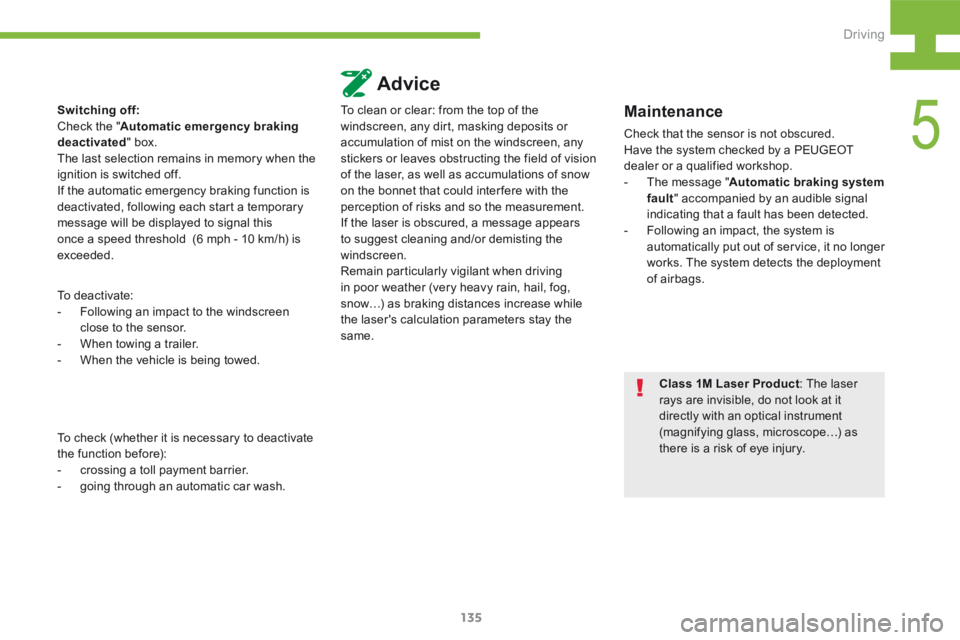
135
208_en_Chap05_conduite_ed01-2015
Switching off:
Check the "Automatic emergency braking
deactivated " box.
The last selection remains in memory when the
ignition is switched off.
If the automatic emergency braking function is
deactivated, following each start a temporary
message will be displayed to signal this
once a speed threshold (6 mph - 10 km/h) is
exceeded.
To deactivate:
- Following an impact to the windscreen
close to the sensor.
- When towing a trailer.
- When the vehicle is being towed.
To check (whether it is necessary to deactivate
the function before):
- crossing a toll payment barrier.
- going through an automatic car wash.
Advice
To clean or clear: from the top of the
windscreen, any dirt, masking deposits or
accumulation of mist on the windscreen, any
stickers or leaves obstructing the field of vision
of the laser, as well as accumulations of snow
on the bonnet that could inter fere with the
perception of risks and so the measurement.
If the laser is obscured, a message appears
to suggest cleaning and/or demisting the
windscreen.
Remain particularly vigilant when driving
in poor weather (very heavy rain, hail, fog,
snow…) as braking distances increase while
the laser's calculation parameters stay the
same.Maintenance
Check that the sensor is not obscured.
Have the system checked by a PEUGEOT
dealer or a qualified workshop.
- The message " Automatic braking system
fault " accompanied by an audible signal
indicating that a fault has been detected.
- Following an impact, the system is
automatically put out of service, it no longer
works. The system detects the deployment
of airbags.
Class 1M Laser Product : The laser
rays are invisible, do not look at it
directly with an optical instrument
(magnifying glass, microscope…) as
there is a risk of eye injury.
5
Driving
Page 145 of 341
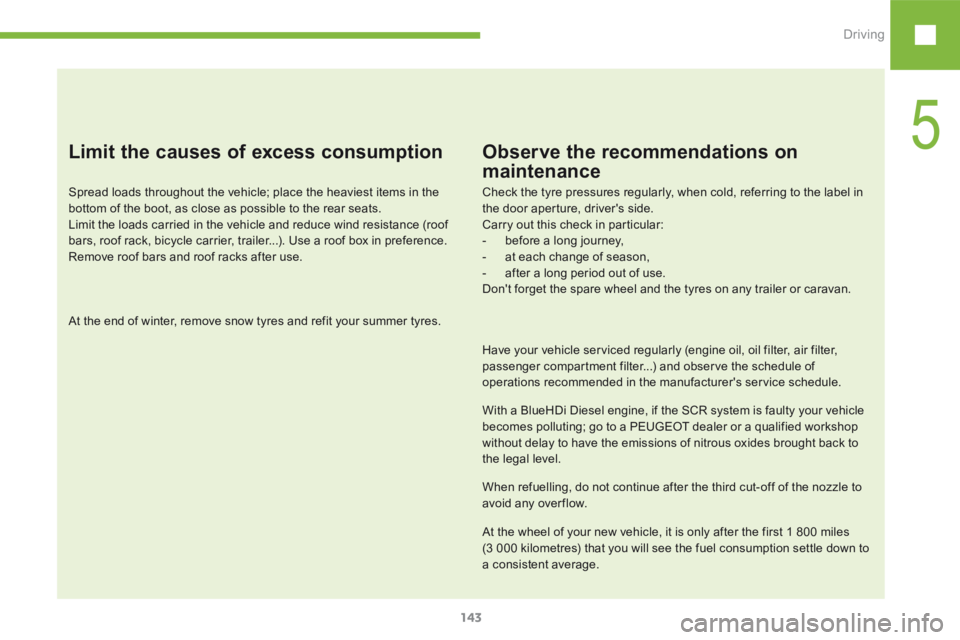
143
208_en_Chap05_conduite_ed01-2015
Limit the causes of excess consumption
Spread loads throughout the vehicle; place the heaviest items in the
bottom of the boot, as close as possible to the rear seats.
Limit the loads carried in the vehicle and reduce wind resistance (roof
bars, roof rack, bicycle carrier, trailer...). Use a roof box in preference.
Remove roof bars and roof racks after use.
At the end of winter, remove snow tyres and refit your summer tyres.
Observe the recommendations on
maintenance
Check the tyre pressures regularly, when cold, referring to the label in
the door aperture, driver's side.
Carry out this check in particular:
- before a long journey,
- at each change of season,
- after a long period out of use.
Don't forget the spare wheel and the tyres on any trailer or caravan.
Have your vehicle serviced regularly (engine oil, oil filter, air filter,
passenger compartment filter...) and observe the schedule of
operations recommended in the manufacturer's service schedule.
With a BlueHDi Diesel engine, if the SCR system is faulty your vehicle
becomes polluting; go to a PEUGEOT dealer or a qualified workshop
without delay to have the emissions of nitrous oxides brought back to
the legal level.
When refuelling, do not continue after the third cut-off of the nozzle to
avoid any over flow.
At the wheel of your new vehicle, it is only after the first 1 800 miles
(3 000 kilometres) that you will see the fuel consumption settle down to
a consistent average.
5
Driving
Page 167 of 341
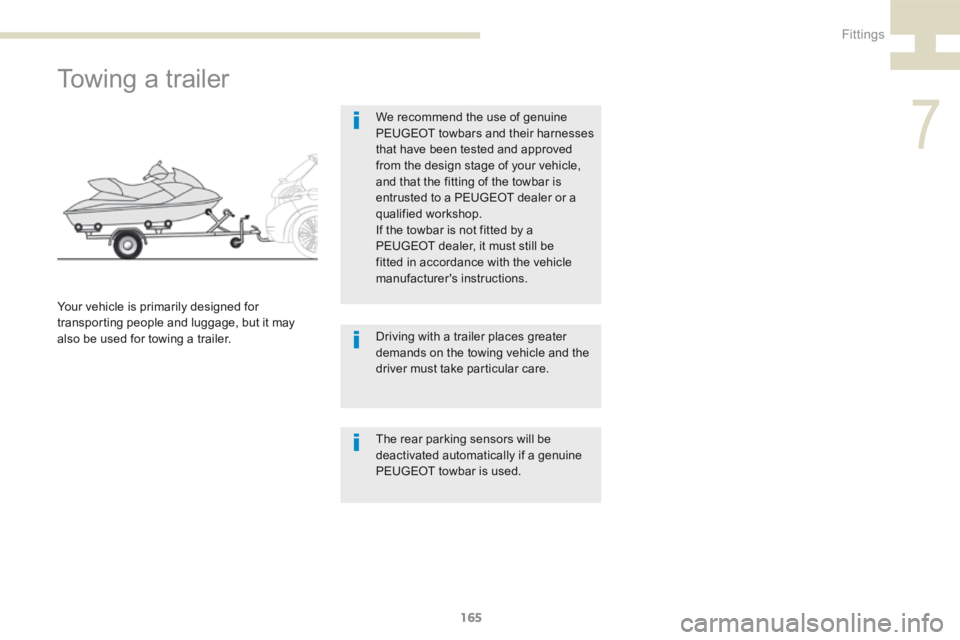
165
208_en_Chap07_ Amenagements_ed01-2015
Towing a trailer
We recommend the use of genuine
PEUGEOT towbars and their harnesses
that have been tested and approved
from the design stage of your vehicle,
and that the fitting of the towbar is
entrusted to a PEUGEOT dealer or a
qualified workshop.
If the towbar is not fitted by a
PEUGEOT dealer, it must still be
fitted in accordance with the vehicle
manufacturer's instructions.
Your vehicle is primarily designed for
transporting people and luggage, but it may
also be used for towing a trailer. Driving with a trailer places greater
demands on the towing vehicle and the
driver must take particular care.
The rear parking sensors will be
deactivated automatically if a genuine
PEUGEOT towbar is used.
7
Fittings
Page 168 of 341
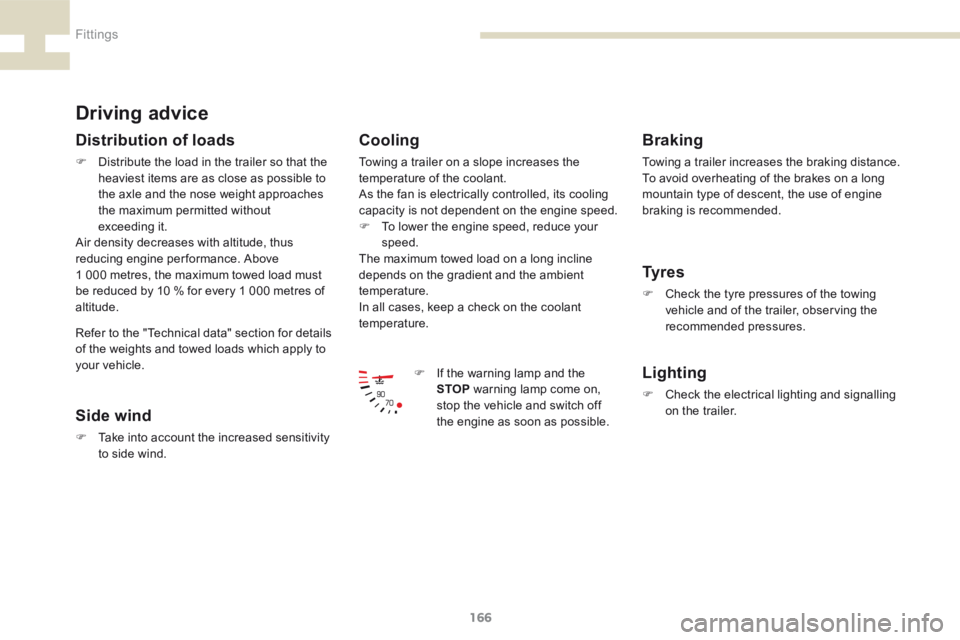
166
208_en_Chap07_ Amenagements_ed01-2015
Driving advice
Distribution of loads
F Distribute the load in the trailer so that the
heaviest items are as close as possible to
the axle and the nose weight approaches
the maximum permitted without
exceeding it.
Air density decreases with altitude, thus
reducing engine performance. Above
1 000 metres, the maximum towed load must
be reduced by 10 % for every 1 000 metres of
altitude.
Side wind
F Take into account the increased sensitivity
to side wind.
Cooling
Towing a trailer on a slope increases the
temperature of the coolant.
As the fan is electrically controlled, its cooling
capacity is not dependent on the engine speed.
F To lower the engine speed, reduce your
speed.
The maximum towed load on a long incline
depends on the gradient and the ambient
temperature.
In all cases, keep a check on the coolant
temperature.
F If the warning lamp and the
STOP warning lamp come on,
stop the vehicle and switch off
the engine as soon as possible.
Braking
Towing a trailer increases the braking distance.
To avoid overheating of the brakes on a long
mountain type of descent, the use of engine
braking is recommended.
Ty r e s
F Check the tyre pressures of the towing
vehicle and of the trailer, observing the
recommended pressures.
Lighting
F Check the electrical lighting and signalling
on the trailer.
Refer to the "Technical data" section for details
of the weights and towed loads which apply to
your vehicle.
Fittings
Page 176 of 341
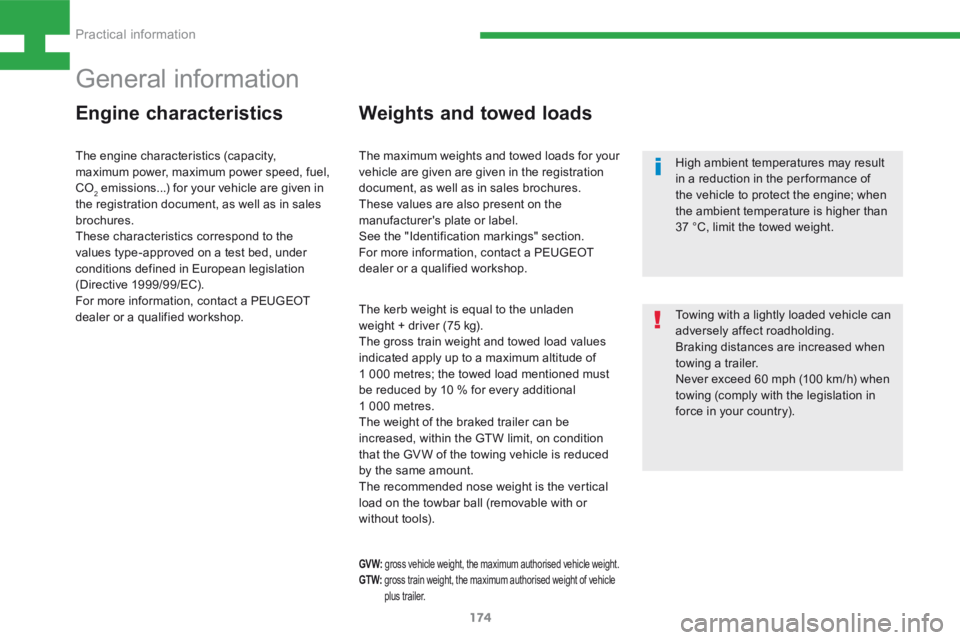
174
208_en_Chap08_Informations-pratiques_ed01-2015
General information
Engine characteristicsWeights and towed loads
The kerb weight is equal to the unladen
weight + driver (75 kg).
The gross train weight and towed load values
indicated apply up to a maximum altitude of
1 000 metres; the towed load mentioned must
be reduced by 10 % for every additional
1 000 metres.
The weight of the braked trailer can be
increased, within the GTW limit, on condition
that the GV W of the towing vehicle is reduced
by the same amount.
The recommended nose weight is the vertical
load on the towbar ball (removable with or
without tools). High ambient temperatures may result
in a reduction in the per formance of
the vehicle to protect the engine; when
the ambient temperature is higher than
37 °C, limit the towed weight.
Towing with a lightly loaded vehicle can
adversely affect roadholding.
Braking distances are increased when
towing a trailer.
Never exceed 60 mph (100 km/h) when
towing (comply with the legislation in
force in your country).
GV W:
gross vehicle weight, the maximum authorised vehicle weight.
GT W: gross train weight, the maximum authorised weight of vehicle
plus trailer.
The engine characteristics (capacity,
maximum power, maximum power speed, fuel,
CO
2 emissions...) for your vehicle are given in
the registration document, as well as in sales
brochures.
These characteristics correspond to the
values type-approved on a test bed, under
conditions defined in European legislation
(Directive 1999/99/EC).
For more information, contact a PEUGEOT
dealer or a qualified workshop. The maximum weights and towed loads for your
vehicle are given are given in the registration
document, as well as in sales brochures.
These values are also present on the
manufacturer's plate or label.
See the "Identification markings" section.
For more information, contact a PEUGEOT
dealer or a qualified workshop.
Practical information